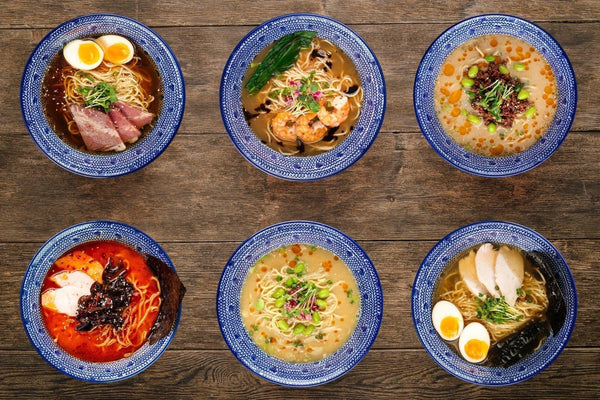
Jump to:
Continuing in our series of articles on ramen, in this edition of the Japanese Taste blog we’ll explore the various types of ramen in Japan.
This steaming bowl of noodles in savory ramen broth, carefully adorned with a variety of ramen toppings, is a symbol of comfort and satisfaction shared across the length and breadth of Japan. Ramen’s popularity now stretches across the globe, with ramen restaurants popping up all the time in the US, Canada, Europe and elsewhere.
But just what exactly is ramen? Is it a uniform food, with only one “proper” way of cooking and serving? Quite the contrary! Ramen is a diverse range of Japanese noodle soups – all of Chinese origin in history, uniquely Japanese in adaptation and evolution.
As ramen in Japan has evolved over the decades, many varieties and subvarieties of ramen have appeared (and have, themselves, evolved and morphed into new ramen styles). Ramen is a constantly flowing (pardon the pun) food staple in Japan, and now sees its evolution continuing around the world.
Let’s explore the many varieties of ramen seen across Japan today, and how ramen varies by region, by ingredients, by preparation technique, by presentation and more.
What Is Ramen? How (And Why) Does It Vary?

When asking what ramen is, let’s consider that, at its core, Ramen is a dish of Chinese origin that has been lovingly adopted and reinvented in Japan.
A bowl of Ramen typically consists of Chinese-style wheat noodles served in a flavorful broth, often flavored with soy sauce (shoyu ramen) or miso, and adorned with a range of ramen toppings such as slices of pork (chāshū), nori (dried seaweed), menma (bamboo shoots) and scallions. Another classic component of the Ramen bowl is the ajitama, a marinated soft-boiled egg that adds depth and richness to the dish.
What sets Ramen apart is its versatility and variety, with different regions of Japan offering their own spin on this comfort food classic. The types of Ramen vary widely across the country, from thick, cloudy pork-bone tonkotsu ramen broth in Kyushu (that’s now become a mainstay in Japan and worldwide), to the salt-based, clear soups in Hakodate – and dozens in between.The choice of ramen toppings also changes regionally, allowing for a virtually limitless variety of flavors and textures.
Ramen lovers will debate and defend their favorite styles of ramen with a passion. But most aficionados of ramen love to explore the many varieties in ramen shops across Japan, and they are constantly in search of the perfect bowl of ramen.
In major cities such as Tokyo, Osaka and elsewhere, many regional varieties of ramen can be found. For example, it’s not difficult to get good Hakata style tonkotsu ramen in Tokyo, and Sapporo style miso ramen shops are plentiful in Osaka. Even Sapporo, which is known as the home of miso ramen, has an abundance of ramen joints serving shio, shoyu and even tonkotsu ramen.
But for our purposes, let’s explore the various regional takes on ramen as attributed to their hometown.
Yokohama Iekei (Family-Style) Ramen

Yokohama, located immediately to the southwest of Tokyo and Japan's second most populous city, is a good place to start our exploration of Japan’s regional ramen varieties. Why? Yokohama was one of the first Chinese settlements in Japan, and today is home to Japan’s largest Chinatown. Yokohama played a pivotal role in the adaptation of ramen in Japan of what had originally been a Chinese food item.
Yokohama boasts a unique ramen style known as iekei ramen. This hearty and rich ramen variety seamlessly blends Tokyo's soy-sauce based ramen broth with Kyushu's flavorful tonkotsu ramen broth, creating a delightful fusion that appeals to ramen lovers nationwide.
The distinguishing feature of Yokohama iekei ramen is its thick, straight noodles, substantial enough to stand up to the rich ramen broth. The bowl is typically topped with spinach, chashu pork, nori and a boiled egg, creating a well-rounded, satisfying meal. A trip to Yokohama wouldn’t be complete without an iekei ramen experience. Local favorites include Yoshimuraya and Sugita-ya, renowned for their delicious interpretations of this regional delight.
Hachioji Ramen

Lesser-known but highly worth a quick visit from nearby Tokyo, the Hachioji ramen scene deserves a notable spot in Japan's ramen culture. Originating from Hachioji, a western suburb of Tokyo, this ramen variety features a clear, soy-based ramen broth, accenting the delicate flavors of the soup.
A distinguishing feature is the generous portion of mildly-curled, thick noodles, which – along with savory additions of bean sprouts, chashu and green onions – turn the bowl of ramen into a hearty meal. Hachioji Ramen also often features a hint of pepper and a bit of lard in the ramen broth to further deepen its flavor. Locals and visitors alike value this comforting bowl for its textural contrast and satisfying taste.
Sapporo Ramen – Miso Ramen

Next on our ramen tour takes us north to Hokkaido, and more precisely, its capital city – Sapporo. Known for being the birthplace of miso ramen, Sapporo adds depth to the ramen repertoire with this hearty and filling creation.
Sapporo ramen uses a rich, miso-based ramen broth that pairs wonderfully with thick, curly noodles. A typical bowl comes adorned with generous ramen toppings of stir-fried vegetables, including bean sprouts, corn and cabbage, along with thick slices of succulent chashu pork. During winter, a pat of butter is often added on top to offer an extra layer of richness and warmth.
Head to Ramen Alley, a narrow lane lined with 17 shops each serving its version of Sapporo Ramen, and immerse yourself in the warming, savory pleasure of this Hokkaido specialty.
Asahikawa Shoyu Ramen

North of Sapporo, in fact Japan’s northernmost city, Asahikawa is home to a wonderful creation: Asahikawa shoyu ramen.
This version of shoyu (sauce ramen) is darker and heartier than the shoyu ramen you’d find in Tokyo, for example. Asahikawa shoyu ramen features the addition of burnt lard, which keeps the soup hotter for longer – a handy feature given the harsh winters this place is known for.
A myriad of ramen shops serve shoyu in this city, but the gem of Asahikawa’s ramen scene is, for us anyhow, Aoba.
Hakodate Ramen – Shio Ramen

Hakodate, another culinary gem in Hokkaido, presents ramen lovers with a unique, arguably subtler version of their favorite dish. Hakodate ramen is defined by its clear, salt-based ramen broth, beautifully simple and incredibly flavorful.
The city's proximity to the sea means that the ramen broth often includes seafood like dried squid, flying fish and Rishiri kelp, all lending a unique, umami-packed taste. The noodles are thin and straight, providing a nice contrast to the gentle, savory broth. Hakodate ramen demonstrates that a few high-quality ingredients can make a deeply satisfying dish.
Kyushu: Hakata Tonkotsu Ramen & Kurume Ramen

Moving south to the island of Kyushu, the Hakata district in Fukuoka offers up the ultimate ramen indulgence with Hakata tonkotsu ramen. This popular variety boasts a rich, milky ramen broth made from pork bones simmered for hours until they render a creamy marrow.
Hakata ramen traditionally features thin, straight, firm noodles, perfect for soaking up the rich broth. Topping choices often include chashu and green onions, with pickled ginger and sesame seeds served on the side for added flavor enhancement.
Kurume ramen, originating from the town of Kurume south of Fukuoka, is considered the original version of tonkotsu ramen. Similar to Hakata style, Kurume ramen uses pork bones for its ramen broth, but this ramen subvariety is darker and richer due to longer cooking time and the addition of older broth to the new one in "Yobimodoshi" method. Kurume ramen also often features slightly thicker noodles than Hakata Ramen, providing a delightful textural experience.
Kitakata Ramen

Hailing from the small city of Kitakata in Fukushima Prefecture, the Kitakata Ramen enjoys a reputation as one of the types of ramen holding a top spot among Japan's three regional ramen varieties. In fact, the city of Kitakata has the highest concentration of ramen shops per capita in all of Japan. Kitakata residents take their ramen culture as a matter of civic pride, with around 120 ramen establishments in the area.
Distinguished by its soy-based, light-colored ramen broth, Kitakata ramen is all about delivering subtle, sophisticated flavors. The noodles are flat, thick and chewy; they are made using a high water-content dough that gives their signature texture. Throw in slices of tender chashu, bamboo shoots and green onions, and you've got a bowl of Kitakata ramen that's as comforting as it is tasty.
Champon – Nagasaki’s Version on Ramen

Champon, from Nagasaki, offers a unique departure from the typical ramen, presenting a medley of flavors influenced by Chinese cuisine. That’s because, along with Yokohama, the port city of Nagasaki was home to one of the first Chinese settlements in Japan.
A champon broth is made from pork bones and seafood, resulting in a rich, robust flavor profile that stands up to the hearty ramen toppings which often include a variety of seafood, vegetables and meat. This Nagasaki gem is thick and hearty, and has spread in popularity across Japan; it’s easy to spot Nagasaki champon shops in Tokyo, Nagoya, Sapporo and many other cities.
Champon's noodles are thick and straight, specially designed to not absorb the soup and maintain their firmness. With its origins in feeding Chinese students on a budget, champon offers a substantial, nutritious and satisfying meal that warms up one’s taste buds with its unique blend of flavors.
Mazesoba – No-Soup Ramen

Also known as "mixed noodles," mazesoba presents a vastly different kind of ramen because technically, it's not served with soup. Yes, you read that right – no soup! This makes mazesoba distinct among its ramen counterparts.
A bowl of mazesoba features thick, chewy noodles served with a variety of savory toppings like chashu, soft-boiled egg, green onions and/or nori. It's often drizzled with a flavorful sauce and a side of vinegar or chili oil to liven up the dish. The key is to mix everything together, allowing the sauce and the toppings to blend and coat each noodle in a layer of delectable goodness.
While mazesoba deviates from conventional ramen, it offers a worthwhile dining experience in its own right, featuring strong flavors and matching texture that keeps ramen lovers coming back for more.
Tantanmen – Ramen With A Kick

If you relish some heat in your bowl of ramen, tantanmen is for you. Named after the Szechuan dish Dan Dan noodles and adapted to suit the Japanese palate, tantanmen offers a spicy, flavor-packed experience.
A typical tantanmen serving consists of ramen noodles topped with ground pork, bok choy or spinach, and green onions. The distinguishing element in tantanmen is the broth – a creamy, sesame-flavored concoction laced with a generous dose of chili oil and Szechuan pepper. It carries an irresistible combination of nutty, spicy and savory tastes, providing a comforting heat that's perfect for a chilly day (but trust us, great in the summer too).
This ramen variety has gained immense popularity in recent years, resulting in many ramen joints serving up their fiery interpretations of tantanmen, making it a must-try for spice enthusiasts and ramen lovers alike.
Abura Soba – Another No-Soup Ramen

Abura soba, often referred to as soup-less oil noodles or "oil ramen," is another fascinating variety that challenges standard conceptions about ramen. Consisting of thick, chewy noodles topped with toppings similar to a conventional ramen bowl, Abura soba is served with a soy-based sauce instead of a broth.
The trick is to give it a hearty mix before digging in, ensuring that each strand of noodle is evenly coated in the slick, savory dressing. For those who crave the flavors of ramen without the soup, abura soba presents a satisfying alternative.
Tori Paitan Dashi Ramen (Chicken Dashi)

Tori paitan ramen is distinguished by the heavy use of chicken in creating a rich, creamy ramen broth that’s not dissimilar in texture to tonkotsu ramen. Paitan refers to a white, cloudy broth achieved by boiling chicken bones, cartilage and fat at high heat for many hours.
This process breaks down the collagen, marrow and fat, resulting in a creamy, rich, flavorful ramen broth that coats the noodles and complements your chosen ramen toppings. With its noticeably hearty broth and a clean, pure flavor profile, tori paitan dashi ramen appeals to those who like the richness of tonkotsu ramen but desire chicken over pork-based dishes.
Tsukemen – Soup On The Side, Please

Having become increasingly popular in Japan and among ramen lovers across the globe in recent years, tsukemen is another no-soup form of ramen.
More specifically, tsukemen focuses on preparing the noodles to perfection, then serving them alongside a bowl of tangy, slightly spicy broth that is much thicker than the average ramen broth.
Tsukemen is often served at restaurants that specialize in serving it, though sometimes you’ll see it on the menu along with other types of ramen.
On a hot summer day, for those who don’t want to soak in the steaming broth of ramen, a great alternative with all the other facets of ramen is tsukemen.
Tomato Ramen

Proving that the world of ramen knows no boundaries and continually evolves, tomato ramen is the latest unconventional twist that's making waves in the Japanese ramen scene.
Here, a tomato-based soup replaces the traditional ramen broth, resulting in a tangy, sweet bowl of ramen that's refreshingly unique. Accompanied by thick, substantial noodles and topped with ingredients like cheese, basil and garlic, tomato ramen features flavors reminiscent of a hearty tomato pasta dish but served up in a distinctly ramen-esque style.
Whether you're a ramen traditionalist or a foodie looking for the next new thing, tomato ramen is an intriguing proposition worth tasting.
Hiyashi Ramen

Got the midsummer blues thanks to the oppressive heat and humidity of Japan’s summers?
What if we told you there was a ramen variant for the warmer months?!
Meet hiyashi ramen, a chilled, refreshing bowl of ramen that's perfect to beat the summer heat in Japan. While there are many versions of cold ramen, hiyashi ramen is unique for its layers of colorful toppings neatly arranged over chilled noodles, all bathed in a tangy, chilled soy or sesame based broth.
Toppings vary widely but often include ingredients like cucumber, ham, tomatoes, boiled eggs and/or chicken. For those who can't imagine a hot bowl of ramen in the sweltering summer, hiyashi ramen offers a delightfully refreshing alternative.
Check out our article that features a hiyashi chuka recipe, a variation of hiyashi ramen with a vinegar and soy-based sauce that you can try at home!
Kyoto Ramen – On The Beaten Path (But Still Noteworthy)

In the ancient capital city of Kyoto, ramen exhibits the finesse and subtlety the city is renowned for. Since Kyoto is on the itinerary for most visitors to Japan, why not check out one of its ramen joints while you’re in town?
Kyoto ramen is typically served in a rich, soy-based ramen broth. The noodles are thick and chewy, soaking up the savory broth wonderfully, and the topping of charred green onions provides a distinctive touch.
Often, the ramen houses in Kyoto maintain a traditional Japanese ambience, augmenting your dining experience further. In a city of refined tastes, Kyoto ramen provides a comforting, flavorful bowl that upholds the city's culinary elegance amidst the vast ramen landscape.
Onomichi Ramen – When In Hiroshima

Onomichi, a smaller city in Hiroshima Prefecture, is famous for its own ramen style. But you don’t even have to venture further afield to Onomichi to find it, as Onomichi ramen shops are widely available in the city of Hiroshima which many visit during their stay in Japan.
This ramen variant from Hiroshima prefecture is a soy-based fish and pork broth, thick, flat-style noodles, and ramen toppings like roast pork, bamboo shoots and green onions. The characteristic element in the Onomichi ramen is the addition of chicken or pork fat droplets (similar to lard) added to the ramen broth, bringing a satisfying level of richness to the bowl.
Okinawa Soba

Ending this ramen journey in the south, Okinawa soba is a unique dish that, despite its name, isn't technically a type of ramen.
Okinawa soba noodles are made from wheat, but are thicker and more akin to udon noodles. They are served in a clear, bonito-based broth with thick slices of stewed pork belly (Soki), and garnished with green onions and red pickled ginger.
The resulting bowl is lighter than most ramen but no less satisfying, reflecting the subtropical climate of the region. Okinawa soba is a beloved dish in the region, and is an excellent example of how regional influences shape and define each unique bowl of ramen.
The Endless Journey For Ramen Lovers
Whether you're slurping shoyu ramen in Tokyo, enjoying the creamy broth of Hakata's tonkotsu ramen, or delighting in the refreshing bite of a midsummer’s hiyashi ramen, the joy of discovery is one of the best parts of diving into Japan's ramen universe.
Each city, town and region puts its unique stamp on ramen, creating an extraordinary food culture where each bowl tells a story of its place of origin.
What’s your favorite style or regional variant of ramen? We’d love to hear in the comments.


0 comments